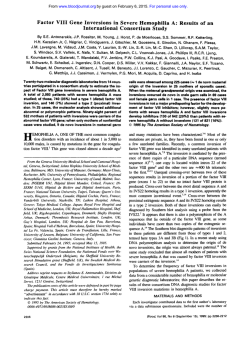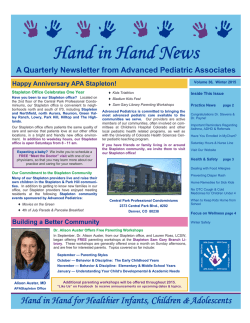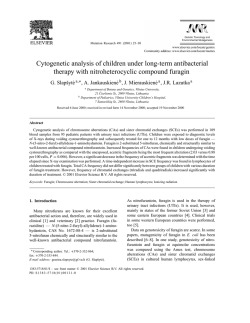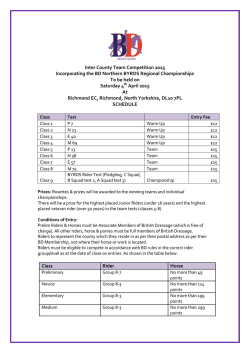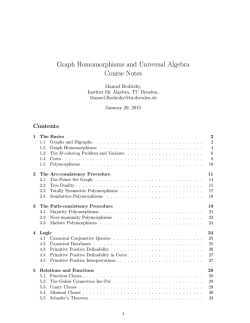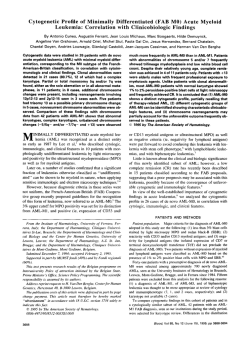
PDF file
Research Note MEDIUM-TERM CHANGES IN DROSOPHILA SUBOBSCURA CHROMOSOMAL INVERSION POLYMORPHISM: A POSSIBLE RELATION WITH GLOBAL WARMING? Goran Zivanovic1, Conxita Arenas2 and Francesc Mestres3 1 Department of Genetics, Institute for Biological Research “SinisaStankovic”. University of Belgrade, Serbia. 2 Departament d’Estadística, Universitat de Barcelona, Barcelona, Spain. 3 Departament de Genètica, Universitat de Barcelona, Barcelona, Spain. Corresponding author: Goran Zivanovic Department of Genetics, Institute for Biological Research “SinisaStankovic”, University of Belgrade, BulevarDespotaStefana 142, 11000 Belgrade, Serbia E-mail: [email protected] Running title: Medium-term inversion changes and global warming Keywords: D. subobscura, inversions, global warming, adaptation 1 Abstract Drosophila subobscura is a species with a rich chromosomal polymorphism for inversions. Evidence demonstrates that it is adaptive. This adaptation has been observed in seasonal changes of the chromosomal polymorphism (short-term variation). Additionally, long-term variation in the composition and frequencies of inversions has been found in accordance with global warming expectations.In the present research, we have studied whether it is possible to detect changes in the inversion chromosomal polymorphism of D. subobscura in a medium-term period of time. The Serbian population of Avala was selected and its inversion composition in 2004 and 2011 (a seven years period) was compared. Significant variation was found for the U chromosome. This result was due to a significant increase of U1+2(warm) and a decrease of Ust(cold) and U1+2+6. Furthermore, minimum, maximum and mean temperatures increased (although not significantly). Thus, U chromosome seems to be able to react in a medium-term to temperature changes in the way expected by the global warming. Introduction Drosophila subobscura is a species with a rich inversion chromosomal polymorphism. Karyotype is composed of five acrocentric (X=A, E, J, O, U) and one dot chromosomes, with E and O being the most polymorphic for inversions (Krimbas 1992, 1993). Although historic factors cannot be ruled out, nowadays it is generally accepted that this polymorphism is adaptive (for a revision see Zivanovic et al. 2012; Pegueroles et al. 2013). It is well known that it varies seasonally (Fontdevilaet al. 1983; RodriguezTrelleset al. 1996), and we have observed this kind of variation in Serbian populations(Zivanovic 2007; Zivanovic and Mestres 2010b).Long-term changes according to global warming expectations have been observed in this species (Orengo 2 and Prevosti 1996; Rodríguez-Trelles and Rodríguez 1998; Soléet al. 2002; Balanyàet al. 2004, 2006, 2009). We have also reported this effect in several studies carried out in the Balkans (Zivanovic and Mestres 2010a, 2011; Zivanovic et al. 2012). The aim of the present research has been to assess whether in a medium-term period of time it is possible to detect changes in the inversion chromosomal polymorphism of D. subobscura. In a parallel way, variationsin the following temperature measures, maximum, minimum and mean, have been also analyzed. We studied Avala (Serbia) population of D. subobscura in 2004, and we had the opportunity to collect flies again in 2011, exactly in the same location. Material and Methods Drosophila subobscura flies were collected from AvalaMountain (Serbia) population (44º48´N 20º30’E), located at 18km south of Belgrade. The physicaland biological characteristics of the trapping place were described in Zivanovic and Mestres (2010b). Collections were obtained in 2004 (from the 2nd to 9th of June) and in 2011 (from the 30th of May to the 5th of June), strictly in the same place. The second sample was obtained many days earlier because spring/summer has advanced approximately 2.5 days per decade in Europe (Menzelet al. 2006).Maximum, minimumand mean temperatures, and rainfall data were obtained from Republic Hydrometeorological Service (Serbia). Wild males and one son of each wild female were individually crossed with virgin females of the Küsnacht strain, which is homokaryotypic for standard chromosomal arrangements in all five chromosomes (Zollinger 1950). Third instar larvae from the F1 were dissected and polytene chromosomes were stained and squashed in aceto-orcein solution. For each cross at least eight larvae were analyzed. All crosses 3 were carried out in individual vials with 25 ml standard corn-meal-sugar-agar-yeast medium and maintained at 18ºC, 60% relative humidity and 12h/12h light/dark cycle. Fisher’s exact test was used (statistically significant p-value< 0.05) to compare the chromosomal composition between 2004 and 2011. This test has been used, because it is more precise than chi-squared test when the expected frequencies are small. The corresponding p-values were obtained using the bootstrap procedure (100000 runs). As described in Zivanovic et al. (2012), for analyzing the temperature changes along years a time series analyses was carried out. For all these computations, R package was used (http://CRAN.R-project.org). Results Inversion chromosomal polymorphisms from 2004 and 2011 samples are presented in Table 1. There were no significant differences for the A chromosome (p = 0.838), J (p = 1), E (p = 0.569) and O (p = 0.874). However, there were significant differences for the U chromosome (p = 0.008). Using the classification of Menozzi and Krimbas (1992) in “cold” and “warm” arrangements, Ust (cold) showed a slight decrease (p = 0.417), but U1+2(warm)showed a significant increase (p = 0.003), and the difference was significant evenafter Bonferroni correction. Finally, U1+2+6 decreased (p = 0.118) and U1+8+2(warm) showed a negligible increase (p = 0.785). In general, the pattern ofchanges for the U chromosome agrees with the global warming expectations.As previously mentioned, changes over time were not significant for other chromosomes, but a qualitative observation allows us to conclude that no variation was present for the A and J chromosomes. Thus, comparing the variation in frequency of “cold” inversions(Ast and A1) with that of “warm” inversion (A2), no changes were observed between 2004 and 2011. For the J chromosome, the only inversions observed (Jst classified as “cold” and 4 J1 considered “warm”) did not show any changes over the period of time analyzed. Considering E chromosome, Est (“cold”) showed a slight decrease (p = 0.848), but the “warm” E1+2+9 also decreased (p = 0.627). The “warm” adapted E1+2+9+12 (not present in 2004) increased (p = 0.299). Finally for the O chromosome,Ost (“cold”) frequency slightly increased (p = 1), and among the “warm” adapted, O3+4 decreased (p = 0.755), whereas O3+4+1(p = 1) and O3+4+8(p = 0.527) increased. FollowingRegoet al. (2010), we have tested whetherthere were differences between “cold” and “warm” groups of inversions in this seven year period. Analyzing all chromosomes together there was not significant variation (p = 0.520). Studying each chromosome individually, no significant differences were observed either for the A (p = 1), J (p = 1), E (p = 1), O (p = 1) and U (p = 0.082). With regard to temperature and rainfall variations between 2004 and 2011, data are shown in Table 2.In this period of seven years, maximum temperature increased (25.3 to 26.7 ºC) and the same pattern was recorded for minimum (15.1 to 16.5 ºC) and mean (19.9 to 21.3 ºC) temperatures. Although these measures of temperature showed an increasing trend, none of the changes were significant: maximum (t = 0.693, p = 0.514), minimum (t =1.256, p = 0.256) and mean (t = 0.876, p = 0.415). Rainfall followed an erratic profile as expected under global warming conditions. Discussion In long-term studies, it has been observed that Drosophila subobscurainversions change in frequency according to global warming expectations in three continents (Balanyàet al. 2006). For the medium-term study, our main result is that a significant change in frequency was observed for one of the chromosomes of D. subobscura karyotype. The significant variation for the U chromosome was found in a medium-term period (seven 5 years) and according to global warming expectations, because in this period temperatures tend to increase. Likely, it was due to the significant increase of U1+2(warm) arrangement, whereas U1+2+6 clearly decreases.This later arrangement is considered not associated to temperature adaptation, but is characteristic of the Balkan region (Krimbas1992, 1993). Additionally, another “cold” adapted arrangement (Ust) decreased and a “warm” adapted one (U1+8+2) increased, both in small proportion. Studying long-term changes, other authors have found significant variations for the U chromosome. Thus, De Frutos and Prevoti (1984), in a 21 years study and analyzing different sites of the same locality (Tibidabo hill, near Barcelona) found significant changes for the U, A, E and O chromosomes. In the same place and continuing the previous research, Orengo and Prevosti (1996) found significant variations for the U1+2and U1+8+2 arrangements. In another long-term study, Soléet al. (2002) found a significant effect for the U chromosome in Montpellier (south of France) and Calvià(Majorca Island). In another long-term analysis using Atlantic and Central Europe populations, significant differences in frequency for the U and O chromosomes were also detected (Balanyàet al. 2004). Finally in the Balkans, Zivanovic and Mestres (2011) found a significant variation for the U chromosome in Apatin (Serbia) population during 1994-2009 period of time. In this case, results were similar to those presented in the present research: Ust (cold) significantly decreased, U1+2(warm)significantly increased and U1+8+2 (also considered “warm”)was found for the first time in this population. Similar results were found atPetnica (Serbia) for the period 1995-2010 (Zivanovic et al. 2012):Ust(cold) slightly decreased, U1+2+6 dramatically decreased, and U1+2and U1+8+2 (both considered “warm”) clearly increased. 6 We speculate that U chromosome responds to medium and long-term changes because it presents a reduced number of arrangements in most studied populations. Furthermore, the majority of these arrangementsare associated with temperature. Maybe they do not react directly to temperature, but to an environmental factor linked to it. However, not all arrangements are adaptive to temperature. As mentioned previously, U1+2+6, is considered to be not related with thermal adaptation, but it israther frequent in the Balkan region and Asia Minor. In particular environmental conditions of this region, it probably presents an adaptive advantage to their carriers.In the Balkans, it has also been observed to decrease in frequency over time in different studies (Zivanovic and Mestres 2011; Zivanovic et al. 2012), likely due to some kind of environmental changes. Thus, it seems that natural conditions are probably changing along the years in these populations and D. subobscurais adapting to them. Acknowledgements This study was supported by grant number 173025 from the Ministry of Education, Science and Technological Development of the Republic of Serbia, grant number CTM2013-48163-C2-2-R from theMinisterio de Economía y Competitividad (Spain) and 2014 SGR 336 and 2014 SGR 464 from the Generalitat de Catalunya (Spain). FM is member of the IRBio (Institut de Recerca de la Biodiversitat, Universitat de Barcelona). References Balanyà J., Solé E., Oller J. M., Sperlich D. and Serra L. 2004 Long-term changes in the chromosomal inversion polymorphism of Drosophila subobscura. II. European populations. J. Zool. Syst. Evol. Res.42, 191−201. Balanyà J., Oller J. M., Huey R. B., Gilchrist G. W. and Serra L. 2006 Global genetic change tracks global climate warming in Drosophila subobscura. Science313, 1773−1775. 7 Balanyà J., Huey R. B., Gilchrist G. W. and Serra L. 2009 The chromosomal polymorphism of Drosophila subobscura: a micro evolutionary weapon to monitor global change. Heredity103, 364−367. De Frutos, R. and Prevosti, A. 1984 Temporal changes of chromosomal polymorphism in natural populations of Drosophila subobscura.Genetica63, 181−187. Fontdevila A., Zapata C., Alvarez G., Sanchez L., Méndez J. and Enriquez I. 1983 Genetic coadaptation in the chromosomal polymorphism of Drosophila subobscura. I. Seasonal changes of gametic disequilibrium in a natural population. Genetics105, 935– 955. Krimbas, C. B. 1992 The inversion polymorphism of Drosophila subobscura. InDrosophila inversion polymorphism(eds. C. B. Krimbasand J. R.Powell), pp. 127−220. CRC Press, Inc. Boca Raton, FL. Krimbas, C. B. 1993 Drosophila subobscura: Biology, Genetics and Inversion polymorphism. Verlag Dr. Kovac, Hamburg. Menzel A., Sparks T. H., Estrella N., Koch E., Aasa A., Ahas R., Alm-Kubler K. et al. 2006 European phenological response to climate change matches the warming pattern. Global Change Biol.12, 1969−1976. Menozzi, P. and Krimbas, C.B. 1992 The inversion polymorphism of Drosophila subobscurarevisited: synthetic maps of gene arrangements frequencies and their interpretation. J. Evol. Biol.5, 625−641. Orengo D.J. and Prevosti A. 1996 Temporal changes in chromosomal polymorphism of Drosophila subobscura related to climatic changes. Evolution 50, 1346–1350. Pegueroles C., Aquadro C. F., Mestres F. and Pascual M. 2013 Gene flow and gene flux shape evolutionary patterns of variation in Drosophila subobscura. Heredity110, 502– 529. Rego C., Balanyà J., Fragata I., Matos M., Rezende E. L. and Santos M. 2010 Clinal patterns of chromosomal inversion polymorphism in Drosophila subobscura are partly associated with thermal preferences and heat stress resistance. Evolution64, 385–397. Rodríguez-Trelles F. and Rodríguez M. A. 1998 Rapid micro-evolution and loss of chromosomal diversity in Drosophila in response to climate warming.Evol. Ecol.12, 829–838. Rodríguez-Trelles F., Alvarez G. and Zapata C. 1996 Time-series analysis of seasonal changes of the O inversion polymorphism of Drosophila subobscura. Genetics142, 179−187. Solé E., Balanyà J., Sperlich D. and Serra L. 2002 Long-term changes in the chromosomal inversion polymorphism of Drosophila subobscura. I. Mediterranean populations from southwestern Europe. Evolution56, 830−835. 8 Zivanovic, G. 2007 Seasonal changes in chromosomal inversion polymorphism in a Drosophila subobscura natural population from a Southeastern European continental refugium of the last glaciation period. Russ. J. Genet.43, 1344−1349. Zivanovic G. and Mestres F. 2010a Viabilities of Drosophila subobscura homo- and heterokaryotypes at optimal and stress temperatures. I. Analysis over several years. Hereditas147, 70−81. Zivanovic G. and Mestres F. 2010b Viabilities of Drosophila subobscura homo- and heterokaryotypes at optimal and stress temperatures. II. Seasonal component analysis. Hereditas147, 82−89. Zivanovic G. and Mestres F. 2011 Changes in chromosomal polymorphism and global warming: the case of Drosophila subobscura from Apatin (Serbia). Genet.Mol. Biol.34, 489−495. Zivanovic G., Arenas C. and Mestres F. 2012 Short- and long-term changes in chromosomal inversion polymorphism and global warming: Drosophila subobscura from the Balkans. Isr. J. Ecol. Evol.58, 289−311. Zollinger, E. 1950 Ein strukturell homozygoter Stamm von Drosophila subobscura aus einer Wildpopulation. Arch. Klaus-Stift. Vererb.-Forsch.25, 33−35. Received 30 June 2014, in final revised form 23 January 2015; accepted 30 January 2015 Unedited version published online: 2 February 2015 9 Table 1. Frequencies of chromosomal inversions from the Avala Mountain population of D. subobscura, both in 2004 and 2011. n stands for the number of chromosomes. 2004 2011 Chrom. inversion n % n % Ast (cold) 14 45.2 20 40.0 A1 (cold) 9 29.0 18 36.0 A2 (warm) 8 25.8 12 24.0 Total 31 Jst (cold) 13 21.0 22 22.0 J1 (warm) 49 79.0 78 78.0 Total 62 Ust (cold) 8 12.9 8 8.0 U1+2 (warm) 20 32.2 57 57.0 U1+2+6 29 46.8 25 25.0 U1+8+2 (warm) 5 8.1 10 10.0 Total 62 Est (cold) 15 24.2 22 22.0 E1+2 2 3.2 2 2.0 E1+2+9 (warm) 31 50.0 45 45.0 / / 4 4.0 E8 14 22.6 27 27.0 Total 62 E1+2+9+12 (warm) 50 100 100 100 10 Ost (cold) 12 17.1 18 18.0 O6 2 2.9 / / O3+4 (warm) 33 47.2 44 44.0 O3+4+1 (warm) 7 10.0 11 11.0 O3+4+2 / / 2 2.0 O3+4+5 3 4.3 2 2.0 O3+4+6 1 1.4 2 2.0 O3+4+7 1 1.4 1 1.0 O3+4+8 (warm) 3 4.3 7 7.0 O3+4+17 / / 1 1.0 O3+4+22 8 11.4 12 12.0 Total 70 100 Inversions and arrangements are classified as “cold-adapted” (cold) and “warm-adapted” (warm) according to Menozzi and Krimbas (1992). Table 2. Meteorological data for the Avala Mountain population for the month of June from 2004 to 2011. Years Max. T (ºC) Min. T (ºC) Mean T (ºC) Rainfall (mm) 2004 25.3 15.1 19.9 113.3 2005 24.5 14.8 19.6 107.1 2006 24.2 15.6 19.8 127.1 2007 28.4 17.7 23.0 59.6 2008 27.4 17.5 22.2 84.6 2009 25.1 15.6 20.1 150.6 2010 25.0 16.2 20.5 172.1 2011 26.7 16.5 21.3 43.2 Max. T and Min. T stand for maximum and minimum temperatures, respectively. 11
© Copyright 2025

